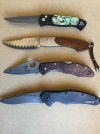not2sharp
Platinum Member
- Joined
- Jun 29, 1999
- Messages
- 19,876
I have been collecting for a long time and can remember back when damascus was considered a magical steel. That was long before the flood of cheap Pakistani and India made stuff associated the steel type with junk in most peoples minds. There is no denying that it is an attractive blade treatment, which when done right can result in good blades. But, I find it harder to say that it is any better than forging a knife from a good quality homogenous blade stock.
we haven't visited this topic in some time. Let us know how you feel about Damascus steel.
n2s
we haven't visited this topic in some time. Let us know how you feel about Damascus steel.
n2s


 IMG_0538
IMG_0538 IMG_0541
IMG_0541